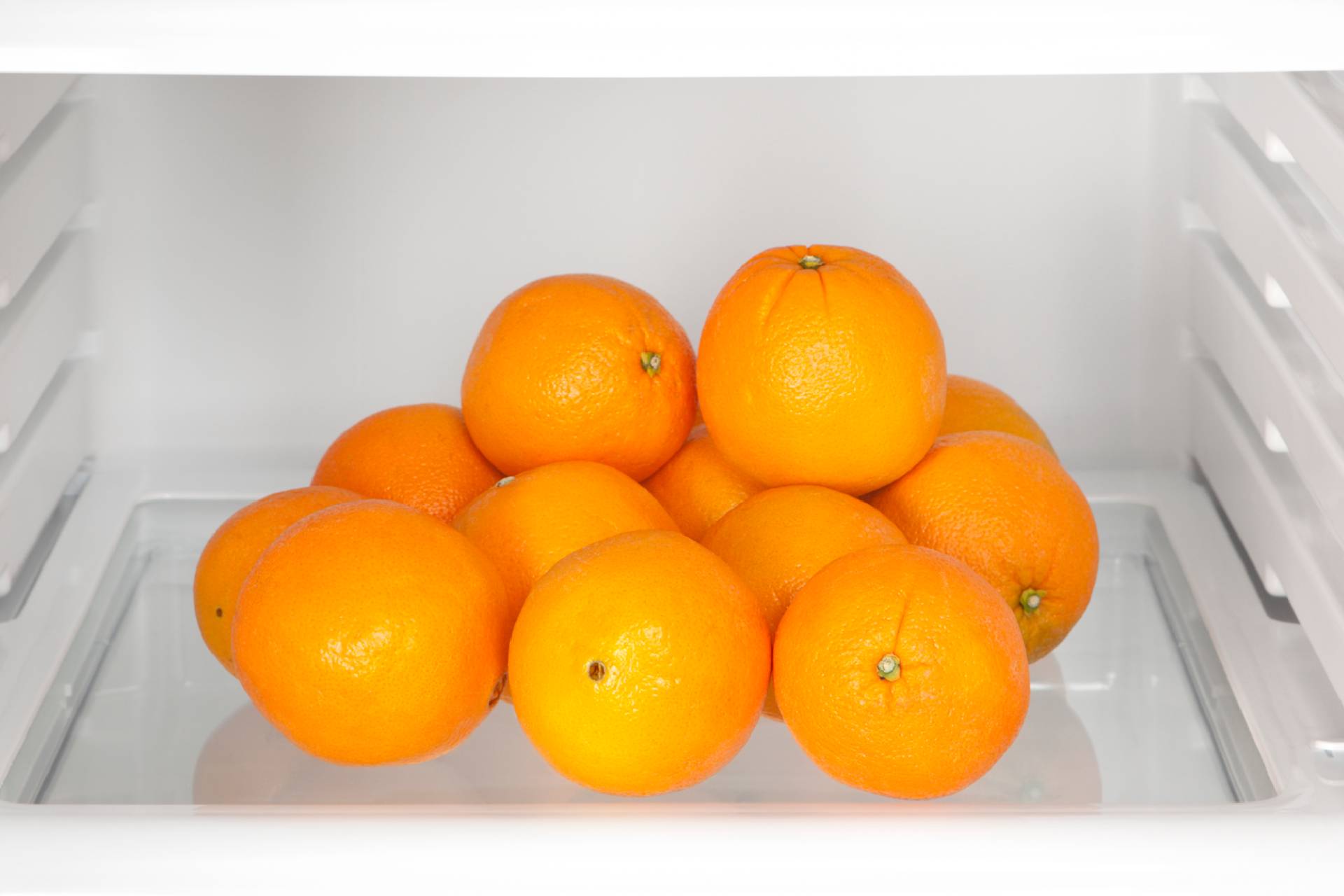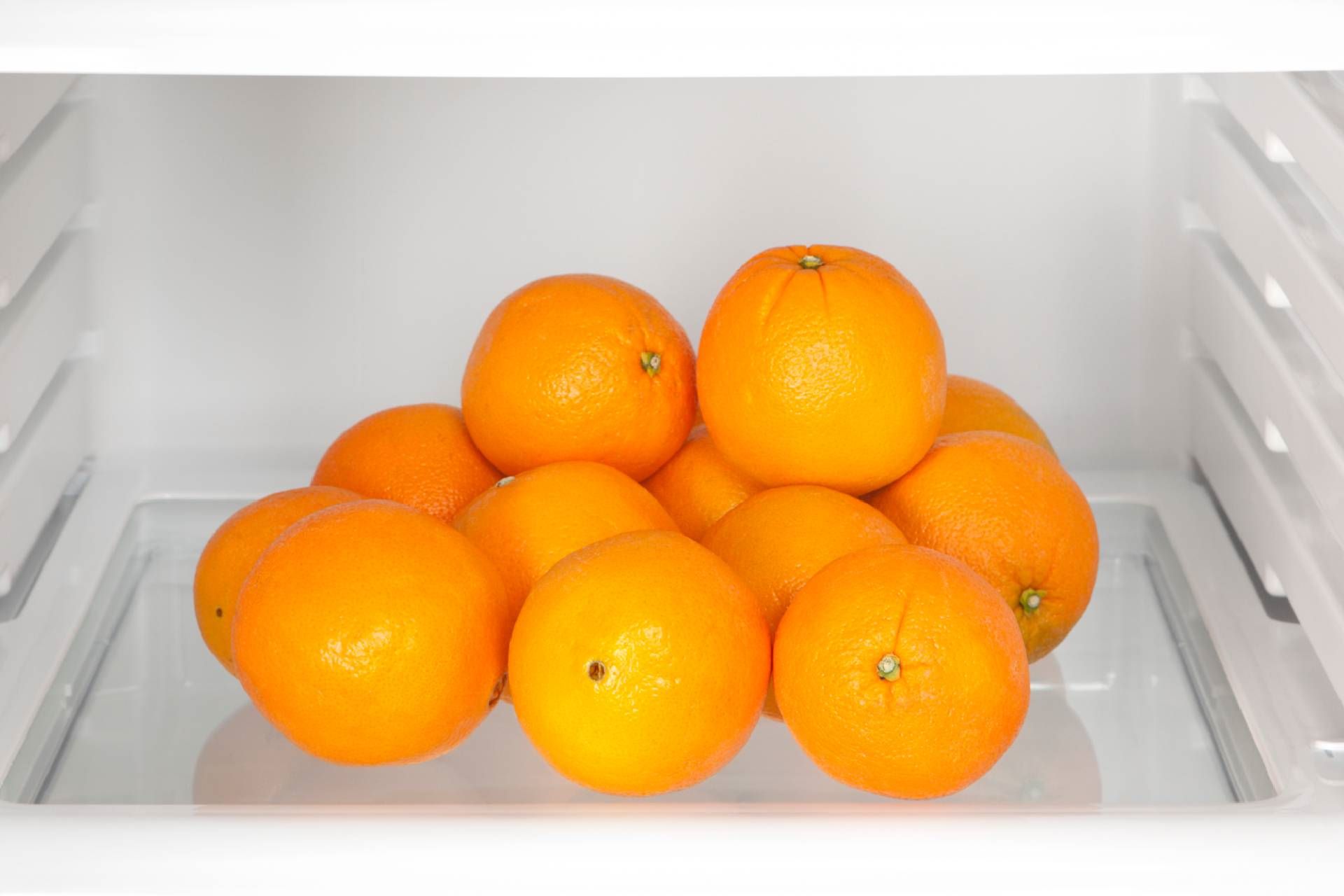

Articles
How To Store Navel Oranges
Modified: December 7, 2023
Learn the best methods for storing navel oranges in this informative article. Keep your oranges fresh and delicious for longer periods with these helpful tips.
(Many of the links in this article redirect to a specific reviewed product. Your purchase of these products through affiliate links helps to generate commission for Storables.com, at no extra cost. Learn more)
Introduction
Welcome to our comprehensive guide on how to store navel oranges. Navel oranges are a delicious and nutritious citrus fruit known for their juicy and sweet flavor. Whether you have a surplus of navel oranges from your backyard tree or you’ve picked up a bulk of them from the grocery store, proper storage is essential to ensure their freshness and taste for as long as possible.
Knowing how to store navel oranges correctly can help you extend their shelf life and enjoy the juicy goodness even weeks after purchase. In this article, we will explore different methods of storing navel oranges to preserve their flavor, texture, and nutritional value. We will also discuss tips and tricks to ensure the quality of the stored oranges and ideas for using them in various culinary creations.
So, whether you plan to enjoy them as a healthy snack, use them in recipes, or simply have a love for these bright, citrusy fruits, let’s dive into the world of storing navel oranges!
Key Takeaways:
- Properly storing navel oranges, whether in the refrigerator or at room temperature, is crucial for maintaining their freshness and flavor. Choosing the right storage location, handling with care, and using proper packaging can help extend their shelf life.
- Stored navel oranges offer a versatile range of culinary possibilities, from fresh juice to desserts and savory dishes. Get creative and explore the vibrant flavor and zest of navel oranges in various cooking creations.
Understanding Navel Oranges
Navel oranges are a popular variety of sweet oranges characterized by their distinct navel-like formation at the blossom end. This unique feature is actually a second fruit embedded at the apex of the main fruit, resembling a tiny bellybutton.
Known for their vibrant orange color and sweet, juicy flesh, navel oranges are a rich source of essential nutrients. They are packed with vitamin C, fiber, and antioxidants, making them a healthy and refreshing addition to any diet.
Navel oranges are typically in season from November to April, although they are available in some regions year-round. Their peak season is during the winter months, when the fruits have the best flavor and juiciness due to cooler temperatures.
When selecting navel oranges, look for fruits that are firm and heavy for their size, with a smooth and brightly colored skin. Avoid oranges with soft spots, blemishes, or wrinkled skin, as these may be signs of age or damage.
The flavor of navel oranges can vary from tart to sweet, depending on the specific variety and ripeness. Generally, the later in the season, the sweeter the oranges become. However, taste preferences vary, so feel free to choose based on your personal preference.
Now that we have a basic understanding of navel oranges, let’s move on to the next section: selecting the perfect navel oranges for storage.
Selecting the Perfect Navel Oranges
Selecting the right navel oranges is the first step towards successful storage. When picking out navel oranges, look for fruits that are firm, plump, and heavy for their size. The skin should be smooth and brightly colored, ranging from deep orange to light orange, depending on the variety.
Avoid navel oranges with soft spots, bruising, or wrinkled skin, as these may indicate poor quality or spoilage. It’s also important to check for any moldy or discolored areas, as this can indicate decay.
Size is not always an indicator of quality, so focus more on the overall appearance and feel of the fruit. Smaller oranges can be just as delicious and juicy as larger ones, so don’t be swayed by size alone.
Additionally, if you have the opportunity to smell the oranges, go for it. A sweet and citrusy aroma is a good sign that the oranges are fresh and ripe.
It’s worth mentioning that some navel oranges may have a slightly puffy or loose skin near the stem end. This is a natural characteristic of the fruit and does not indicate spoilage. However, if the entire skin feels soft and spongy, it is best to avoid those oranges, as they may be overripe.
Remember, the quality of the navel oranges you select will greatly impact their storage life and overall taste. So take your time when choosing them, and aim for the freshest and highest-quality fruits available.
Now that you’ve selected the perfect navel oranges, let’s move on to the next step: preparing them for storage.
Preparing Navel Oranges for Storage
Before storing your navel oranges, it’s important to give them a little bit of preparation. By following these simple steps, you can ensure that your oranges stay fresh and delicious for as long as possible.
First, give the navel oranges a gentle rinse under cool running water. This will help remove any dirt, residue, or pesticides that may be present on the skin. Pat them dry with a clean towel or let them air dry before proceeding.
Next, inspect each orange for any visible signs of damage or spoilage. Remove any oranges that have soft spots, bruises, or mold. It’s crucial to remove any compromised fruit to prevent it from affecting the others during storage.
Once you’ve sorted out the damaged oranges, it’s time to decide on the storage method: refrigeration or room temperature. The choice largely depends on personal preference and how quickly you plan to consume the oranges.
If you prefer colder oranges or want to prolong their freshness, storing them in the refrigerator is the way to go. On the other hand, if you like your oranges at room temperature and plan to consume them within a few days, keeping them out on the counter is a suitable option.
Now that you’ve prepared your navel oranges, let’s delve into the specifics of each storage method, starting with refrigeration.
Choosing the Right Storage Location
When it comes to storing navel oranges, choosing the right location is crucial to maintain their freshness and quality. Whether you decide to store them in the refrigerator or at room temperature, here are some important factors to consider.
If you opt for refrigeration, it’s important to find the optimal spot in your fridge. Ideally, store the navel oranges in the crisper drawer, which is specifically designed to maintain higher humidity levels. This helps prevent the oranges from drying out and extends their shelf life.
Alternatively, if you have a dedicated fruit compartment in your refrigerator, that’s another suitable location for storing navel oranges. The fruit compartment usually provides slightly higher humidity, which is beneficial for keeping the oranges fresh and juicy.
It’s important to note that navel oranges are sensitive to low temperatures, and prolonged exposure to very cold conditions can adversely affect their flavor and texture. Therefore, it’s best to avoid storing them near the back or coldest sections of the refrigerator.
If you decide to store navel oranges at room temperature, choose a cool and well-ventilated area away from direct sunlight. Find a spot in your kitchen or pantry where the temperature remains fairly consistent, preferably between 60°F and 70°F (15°C to 21°C).
Avoid storing navel oranges near heat sources like stoves or ovens, as the warmth can accelerate the ripening process and lead to spoilage. It’s also important to keep them away from other fruits that produce ethylene gas, such as apples and bananas, as this can cause the oranges to ripen and spoil faster.
By choosing the right storage location, you can create an optimal environment for your navel oranges, whether in the refrigerator or at room temperature. With the storage location sorted, let’s move on to specific instructions for each storage method.
Storing Navel Oranges in the Refrigerator
If you prefer to keep your navel oranges cool and prolong their shelf life, storing them in the refrigerator is the best option. Here’s how to do it:
- Place the navel oranges in a clean and dry plastic bag or a perforated plastic produce bag. The bag helps create a microclimate around the oranges, maintaining their moisture while allowing a slight amount of airflow.
- Seal the bag loosely, leaving a small opening or puncturing a few holes on the bag if it’s not perforated. This helps prevent excess moisture buildup and allows some airflow, which aids in preserving the quality of the oranges.
- Store the bagged navel oranges in the crisper drawer or fruit compartment of your refrigerator. Make sure they are separated from other fruits and vegetables to avoid cross-contamination and the potential for ethylene gas production.
- Avoid overcrowding the bag or stacking heavy items on top of the oranges, as this can lead to bruising and damage.
- Keep the temperature in the refrigerator set between 35°F and 45°F (2°C and 7°C) to maintain the freshness of the navel oranges.
- Check the oranges periodically for any signs of spoilage. Remove any oranges that show mold, decay, or other indications of being overripe.
- When you’re ready to enjoy the refrigerated navel oranges, take them out and let them sit at room temperature for a few minutes to enhance their flavor and juiciness.
By following these steps, you can keep your navel oranges fresh and delicious in the refrigerator for up to two weeks. However, keep in mind that the flavor and texture may start to deteriorate over time, so it’s recommended to consume them as soon as possible for the best taste.
Now that you know how to store navel oranges in the refrigerator, let’s explore the alternative option: storing them at room temperature.
Storing Navel Oranges at Room Temperature
If you prefer to enjoy your navel oranges at their natural temperature and plan to consume them within a few days, storing them at room temperature is a suitable option. Here’s how to do it:
- Find a cool and well-ventilated area in your kitchen or pantry away from direct sunlight, heat sources, and other fruits that produce ethylene gas.
- Place the navel oranges in a fruit bowl or a clean, dry basket lined with a soft, breathable material such as a kitchen towel or paper towels. This will help absorb any excess moisture and prevent the oranges from rolling around and getting damaged.
- Make sure the oranges are not piled too high, as this can lead to bruising and spoilage.
- Check the navel oranges occasionally for any signs of spoilage. Remove any oranges that show mold, decay, or other indications of being overripe.
- It’s important to note that storing navel oranges at room temperature can cause them to ripen faster. Therefore, if you find that the oranges are becoming too ripe before you can consume them, it’s best to transfer them to the refrigerator to slow down the ripening process.
- When you’re ready to enjoy the room temperature navel oranges, give them a gentle rinse under cool water and pat them dry before eating.
By storing navel oranges at room temperature, you can maintain their flavor and texture for up to a week. However, keep in mind that the oranges may start to lose some of their juiciness and freshness over time.
Remember to use your senses and check for any signs of spoilage before consuming the navel oranges, regardless of the storage method you choose. Removing any damaged fruits promptly will help prevent the spread of spoilage to the remaining oranges.
Now that you know how to properly store navel oranges at room temperature, let’s explore ways to extend their shelf life by using proper packaging.
Extending Shelf Life with Proper Packaging
Proper packaging can help extend the shelf life of navel oranges, whether you choose to store them in the refrigerator or at room temperature. Here are a few packaging options to consider:
Plastic Bags:
Place the navel oranges in a clean, dry plastic bag or a perforated plastic produce bag. The bag helps create a microclimate around the oranges, maintaining their moisture while allowing for some airflow. This can help prevent the fruit from drying out and prolong its freshness.
Read more: How To Store Halos Oranges
Paper Bags:
If you prefer an alternative to plastic, you can use paper bags to store your navel oranges. Paper bags offer a similar benefit of maintaining moisture while allowing for some airflow. However, keep in mind that paper bags may not provide as much moisture retention as plastic bags.
Airtight Containers:
Another option for storing navel oranges is to place them in airtight containers. This can help maintain their moisture and protect them from exposure to air and other external factors that can lead to spoilage. Make sure the container is clean and dry before adding the oranges.
Mesh Bags:
If you have a lot of navel oranges to store, consider using a mesh bag or a breathable produce bag. These bags allow for good airflow, which can help prevent moisture buildup and maintain the freshness of the fruit. Mesh bags are also convenient for organizing and storing a larger quantity of oranges.
Waxed Paper:
You can individually wrap each navel orange in waxed paper before storing them. This can help prevent moisture loss and protect the fruits from physical damage. Simply place an orange in the center of a piece of waxed paper, fold the paper over the fruit, and secure it with a twist tie or rubber band.
Regardless of the packaging method you choose, make sure to label the bag or container with the date of storage. This will help you keep track of the freshness and identify the oldest oranges for consumption.
Remember, while proper packaging can help prolong the quality and shelf life of navel oranges, it’s still essential to regularly check for any signs of spoilage. Remove any oranges that show mold, decay, or other indications of being overripe to prevent spoilage from spreading to the rest of the fruit.
Now that you know how to extend the shelf life of navel oranges with proper packaging, let’s explore how to check and maintain their quality during storage.
Checking and Maintaining the Quality of Stored Navel Oranges
Monitoring the quality of stored navel oranges is important to ensure their freshness and taste. Here are some tips for checking and maintaining the quality of your stored oranges:
Regular Inspection:
Periodically check the stored navel oranges for any signs of spoilage. Look for mold, soft spots, or any other indications of decay. Remove any damaged oranges immediately to prevent the spread of spoilage to the rest of the fruit.
Handling with Care:
When handling the stored navel oranges, remember to be gentle. Avoid squeezing or dropping them, as this can cause bruising and damage. Treat them with care to maintain their quality and prevent spoilage.
Avoid Moisture Buildup:
Moisture buildup can lead to mold growth and spoilage. Check the storage containers or bags for any excess moisture and wipe them dry if necessary. It’s important to strike a balance between maintaining moisture and preventing excessive dampness.
Read more: How To Store Blood Oranges
Separate Ripening Fruits:
If you notice that some oranges are starting to ripen faster than others, it’s best to separate them. Remove the ripe or overripe oranges from the group and consume them first to prevent spoilage from spreading to the other fruits.
Temperature Control:
Whether stored in the refrigerator or at room temperature, it’s important to maintain a consistent temperature. Keep the refrigerator temperature between 35°F and 45°F (2°C and 7°C). If stored at room temperature, make sure to keep the navel oranges in a cool area away from direct sunlight and heat sources.
Ethylene Gas Control:
Monitor the storage area for ethylene-producing fruits like apples and bananas. Ethylene gas can accelerate the ripening process of navel oranges, leading to faster spoilage. Keep the oranges away from ethylene-producing fruits to maintain their quality and freshness.
By regularly inspecting and maintaining the quality of your stored navel oranges, you can ensure that they remain fresh and delightful for as long as possible. Don’t forget to enjoy them at their peak flavor and juiciness!
Now that you know how to check and maintain the quality of stored navel oranges, let’s move on to some tips for using them in various culinary creations.
Tips for Using Stored Navel Oranges
Stored navel oranges can be incredibly versatile and add a burst of sunshine to a variety of culinary creations. Here are some tips and ideas for using your stored oranges:
Read more: How To Store Orange Zest
Fresh Juice:
Squeeze the juice from your stored navel oranges to enjoy a refreshing glass of citrus goodness. You can enjoy it as is or use it as a base for cocktails, smoothies, or marinades.
Salads:
Add segments of navel oranges to your salads for a burst of sweet and tangy flavor. They pair well with leafy greens, fennel, and nuts. The citrusy taste can uplift the flavors of your salads and provide a delightful contrast.
Desserts:
Use the juice or zest of navel oranges to enhance the flavor of cakes, cookies, and other desserts. The sweet and citrusy notes can complement flavors like chocolate, vanilla, and almond.
Marmalade and Preserves:
Make homemade marmalade or preserves with your stored navel oranges. Simmer the oranges with sugar and water to create a tangy and flavorful spread. Enjoy it on toast, scones, or as a topping for yogurt and pancakes.
Read more: How To Store Dehydrated Oranges
Sauces and Dressings:
Incorporate navel oranges into your sauces and dressings for a zesty kick. The juice or zest can provide a bright flavor to vinaigrettes, glazes, and marinades. Experiment with different combinations to find your favorite citrus-infused creations.
Infused Water or Tea:
Add thin slices of navel oranges to your water or tea for a refreshing and subtly fruity twist. The infusion of citrus can elevate your hydration experience and give you a boost of vitamin C.
Grilled or Roasted:
Grill or roast navel oranges to bring out their natural sweetness and caramelization. The heat intensifies the flavors and adds a unique smoky note. Enjoy them as a side dish or use them as a topping for grilled meats or seafood.
Get creative with your stored navel oranges and let their vibrant flavor shine in a variety of dishes. Experiment with different combinations and techniques to discover new and delightful ways to enjoy these citrus gems.
Now that you have plenty of ideas for using your stored navel oranges, it’s time to wrap up this comprehensive guide. Whether you enjoy them fresh, in desserts, or as part of savory dishes, navel oranges are a versatile and delicious fruit that can brighten up any meal. So go ahead and savor the flavor of these juicy delights!
If you want to continue learning more about other fruits and their storage methods, feel free to reach out. Happy citrus-filled cooking and enjoy your navel oranges!
Conclusion
In conclusion, knowing how to properly store navel oranges is essential to maintain their freshness, juiciness, and flavor for an extended period. Whether you choose to store them in the refrigerator or at room temperature, following the right techniques and considerations will help you enjoy these citrus delights for longer. Taking the time to select the perfect navel oranges, preparing them for storage, and choosing the right storage location are crucial first steps.
Storing navel oranges in the refrigerator provides a cool and controlled environment that helps retain their freshness. The use of plastic bags, paper bags, airtight containers, or mesh bags can contribute to maintaining the ideal moisture balance. On the other hand, storing navel oranges at room temperature is suitable if you plan to consume them within a few days and prefer them at a natural temperature. Proper packaging in fruit bowls or baskets lined with breathable materials can help keep the oranges fresh and protected.
Regularly checking and maintaining the quality of stored navel oranges is essential. Periodically inspecting the oranges for any signs of spoilage, handling them with care, avoiding moisture buildup, and controlling temperature and ethylene gas exposure are vital to ensure their longevity.
Stored navel oranges offer a range of culinary possibilities. From fresh juice to salads, desserts to sauces, there are numerous ways to incorporate these versatile fruits into your cooking. Get creative and explore the delicious ways to enjoy their vibrant flavor and zest.
By following the tips and techniques outlined in this guide, you can extend the shelf life of your stored navel oranges and make the most of their delectable taste. Whether you have a surplus of backyard harvest or a bulk purchase from the store, proper storage will allow you to savor the tangy, sweet goodness of navel oranges for weeks to come.
So, next time you find yourself with a bountiful supply of navel oranges, remember these guidelines to ensure their freshness and taste. Enjoy the burst of sunshine in each bite and the versatile possibilities they bring to your culinary endeavors.
If you have any more questions or want to explore the storage methods of other fruits, feel free to reach out. Happy storing and happy indulging in the delightful world of navel oranges!
Frequently Asked Questions about How To Store Navel Oranges
Was this page helpful?
At Storables.com, we guarantee accurate and reliable information. Our content, validated by Expert Board Contributors, is crafted following stringent Editorial Policies. We're committed to providing you with well-researched, expert-backed insights for all your informational needs.










0 thoughts on “How To Store Navel Oranges”